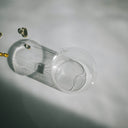If you've ever found yourself combing your hair only to end up with a heart-stopping amount of hair strands stuck between the teeth of your comb, you're not alone.
One major reason behind this startling hair loss is diffuse hair loss, where individuals experience diffuse thinning across their entire scalp.
This condition can strike anyone at any age, leaving a wake of confusion and worry.
But before you resign yourself to a lifetime of hats and scarves, there's some good news. Diffuse hair loss, unlike its more permanent counterparts, is often reversible.
With the right knowledge and a proactive approach, you can stop hair loss and guide your hair back to its former glory.
This article will delve deep into the world of diffuse hair loss - from its complex causes to its innovative treatments.
We will explore the most effective strategies for combating this hair-raising issue and learn how to cultivate a head full of healthy, happy hair.[[textbox]]
Table of content
Summary
Diffuse hair loss can be a distressing condition that affects individuals of all ages. However, with the right knowledge and proactive measures, there is hope for regaining healthy, vibrant hair.
Understanding the underlying causes of diffuse hair thinning, such as stress, male or female pattern hair loss, hormonal imbalances, nutritional deficiencies, and medical treatments, is key to effective treatment.
Treatment options include addressing the underlying condition, utilizing specialized hair growth routines like the Scandinavian Biolabs Hair Growth Routine, using medications like minoxidil and finasteride, exploring platelet-rich plasma therapy, or considering hair transplant procedures.
Each approach has its benefits and considerations, and consulting with a healthcare professional or specialist is essential to determine the most suitable treatment path.
Remember, diffuse hair loss can often be reversible, especially when the underlying cause is addressed promptly.
With the right combination of treatments and a commitment to hair health, you can nurture your hair back to its former glory and regain the confidence that comes with a head full of healthy, happy hair.
[[textbox]]
As your leading source for hair health information over the past 4 years, we never compromise on accuracy. When it comes to your health, you deserve information you can truly rely on - and earning your trust is our top priority.
Here's how Scandinavian Biolabs ensures every piece of content meets the highest standards of accuracy and integrity:
- Credentialed Experts: Our reviewers are actively practicing doctors and medical researchers
- Stringent Reviews: Content undergoes rigorous editing by subject specialists and review by a practicing doctor.
- Evidence-Based: We rely on well-established research from trusted scientific sources like peer-reviewed journals and health authorities.
- Full Transparency: Our editorial standards, writer credentials, reviewer credentials, correction process, and funding are all publicly documented.
- Independent Voice: While we do promote products, we operate in a vacuum to business operations. Our main goal is just an unwavering commitment to providing medically-sound guidance.
You can count on Scandinavian Biolabs to consistently deliver the trustworthy health information you deserve. Read our Editorial Standards.
What is diffuse hair loss?

Diffuse hair loss, or diffuse hair thinning, or diffuse alopecia refers to a general thinning of scalp hair across the entire scalp rather than in specific, localized areas. Male pattern baldness, prevalent in men, typically manifests as a receding hairline or bald spot at the crown. Diffuse hair loss is different from this because it influences the whole scalp uniformly without creating a discernible receding hairline or any specific pattern.
While both forms of hair loss can significantly impact the look of your hair and potentially your self-esteem, they present differently.
With its widespread thinning across the scalp, diffuse hair loss might not be as immediately noticeable as male pattern hair loss. Still, over time it can considerably alter your hair's overall density and volume.
Fortunately, this condition rarely leads to complete baldness.
What causes diffuse thinning?

Diffuse thinning can occur due to a variety of factors. These factors often disturb the natural hair growth cycle, leading to increased hair shedding and decreased hair density.
A healthcare professional may perform a scalp biopsy, a complete blood count, or a hair pull test to confirm the presence of diffuse thinning and determine the underlying cause.
Here are some common causes:
- Physical and emotional stress: Extreme physical or emotional stress can lead to diffuse alopecia. This includes major surgery, severe illness, or traumatic life events.
- Genetics: For some individuals, a genetic predisposition may make them more likely to experience diffuse hair loss.
- Telogen Effluvium: It is a common cause of diffuse thinning. Factors like stress, hormonal shifts, or certain medical conditions trigger this temporary hair loss condition. It involves an abnormal shift of hair from the anagen (growth phase) to the telogen phase, leading to symptoms like bald patches and visible hair loss during grooming. Hair usually regrows after addressing the triggering factor.
- Hormonal changes: Significant changes in hormone levels, as seen during pregnancy, endometriosis, menopause, or due to certain medical conditions like polycystic ovary syndrome (PCOS) or systemic lupus erythematosus, can cause diffuse hair.
- Endocrine disorders: Conditions affecting the endocrine system, such as thyroid imbalances or diabetes, can contribute to this condition in males and females.
- Age: Age is a prevalent cause of diffuse thinning. While hair loss can be normal even in younger years, aging invariably brings about some hair thinning. Some individuals may seek treatment, while others accept it as a natural part of aging.
- Nutritional deficiencies: Lack of essential nutrients such as iron, vitamins, and protein can affect the health of your hair, leading to diffuse thinning.
- Male & female pattern hair loss: Male pattern hair loss, or androgenic alopecia, affects about 50% of men over 50, but it can also impact younger men. According to the Norwood Scale, advanced stages of male pattern baldness are more likely to show visible diffuse thinning. Similarly, female pattern hair loss is a hereditary condition that initially affects the scalp and part-line. Diffuse thinning can develop as it progresses to later stages, impacting the entire scalp.
- Anagen Effluvium: Anagen effluvium is a form of hair loss triggered by severe trauma or toxic treatments like chemotherapy, causing widespread or diffuse hair loss and increased breakage. Sometimes, scalp cooling and scalp hypothermia techniques may be used during chemotherapy to minimize hair loss.
Common signs of diffuse thinning
Like other forms of hair loss, diffuse thinning can manifest abruptly or gradually over several months. The following indicators may be observed:
- Uniform hair loss: Unlike pattern baldness which affects specific areas, diffuse thinning involves uniform hair loss across the entire scalp.
- Thinner ponytail or braid: For those with longer hair, a noticeable decrease in the thickness of your ponytail or braid can be a sign of diffuse thinning.
- Visible scalp: If more scalp is visible when styling your hair or under bright lights, this could be a sign of diffuse thinning.
- Excessive Shedding: Finding excessive hair than usual on your pillow, in your shower drain, or in your hairbrush may indicate diffuse thinning. While shedding 50 to 100 hair daily is part of the normal hair growth cycle, diffuse thinning might result in losing significantly more than this average count each day.
- Decreased Hair Volume: If your hair appears less voluminous or flat, it could be a sign of diffuse thinning.
- Fragile Hair: Hair may become more fragile, leading to excessive hair breakage, which can signify diffuse thinning.
How to treat diffuse thinning
Treating diffuse thinning typically involves addressing the underlying cause of hair loss. This may include lifestyle modifications, nutritional supplements, medications, or in some cases, medical procedures such as low-level laser therapy.
Getting a free consultation with a healthcare professional is crucial to create an appropriate treatment plan based on your situation.
Let’s look at some ways below:
Treat the underlying condition
Treating the underlying condition in the case of diffuse hair loss is of utmost importance for several reasons.
This type of hair loss often results from an underlying condition or factor such as stress, hormonal imbalances, nutritional deficiencies, or medical treatments like chemotherapy.
By addressing the root cause, you not only have the potential to halt or reverse hair loss but also promote overall health and well-being.
Resolving the underlying condition creates a more favorable environment for hair growth, prevents the recurrence of hair loss episodes, and supports long-term hair health.
Consulting with a healthcare professional is vital to accurately diagnose the underlying condition and develop an appropriate treatment plan tailored to your needs.
Scandinavian Biolabs Hair Growth Routine

The Scandinavian Biolabs hair growth routine is designed to help treat hair loss by providing a comprehensive 3-step system.
Formulated by experts, this routine is designed to nourish hair strands and enhance the appearance of hair thickness.
Each product in the routine incorporates plant growth factors derived from stem cell technology, specifically designed to nourish hair follicles and stimulate hair growth.
Key ingredients such as Capilia Longa have been included to nourish hair follicles and improve the appearance of hair density.
Other ingredients, such as niacinamide, aloe vera, amino acid complex, Vanillyl Butyl Ether, and Zinc PCA, support sustained hair growth, soothe the scalp, promote hair strength, enhance blood flow, and regulate sebum production.
Combining these scientifically developed ingredients, the Scandinavian Biolabs hair growth routine offers a comprehensive approach to treating diffuse hair thinning and nurturing optimal hair growth.
Minoxidil
Minoxidil is a topical medication that can treat various forms of hair loss, including diffuse thinning.
It works by prolonging the growth phase of hair follicles, which can slow or stop hair loss and in some cases, promote new hair growth.
Minoxidil may also improve blood supply to the hair follicles, providing them with the necessary nutrients for growth.
Users typically apply topical minoxidil to the scalp twice a day. Over time, it can help increase hair's density and thickness in areas where thinning is occurring.
Finasteride
Finasteride is an oral medication often used to treat hair loss, including diffuse thinning, particularly in men.
It works by blocking the conversion of testosterone into dihydrotestosterone (DHT), a hormone that can shrink hair follicles and lead to hair loss.
By reducing the levels of DHT, finasteride can slow or stop hair loss and in some cases, promote regrowth of hair.
Typically, finasteride is taken once a day. However, as with other hair loss treatments, it may take several months to see noticeable results.
It's important to note that stopping the medication can lead to a return of hair loss. Therefore, those who see positive results are usually advised to continue taking it.
Platelet-rich plasma therapy
Platelet-rich plasma (PRP) therapy is an emerging treatment option for diffuse hair loss. This procedure involves drawing a patient's blood, processing it to isolate the plasma rich in platelets, and injecting this concentrated solution back into the scalp.
When injected into the scalp, these platelets stimulate hair follicles, potentially promoting hair growth and reducing thinning.
This treatment typically involves multiple sessions, and results may take months. As with any procedure, it's vital to consult a healthcare provider to assess its suitability for your specific case of hair loss.
Hair transplant

Hair transplants can be an effective treatment option for addressing diffuse hair thinning. In the case of diffuse hair loss, where thinning occurs across the entire scalp, the hair transplant aims to improve hair density and coverage.
The procedure can restore hair growth naturally and create a more even distribution by transplanting healthy hair follicles into thinning hair areas.
It's important to note that hair transplants require careful evaluation and planning. The availability of an adequate donor area, which is the area of the scalp where the remaining hair is healthy, and the extent of hair loss will determine the feasibility and success of the procedure.
Consulting with a qualified hair transplant specialist is crucial to assess candidacy, discuss expectations, and determine the most appropriate approach for treating diffuse hair loss through transplantation.
Will diffuse hair loss grow back?
In many cases, hair loss from this condition has the potential to grow back. The outcome depends on the underlying cause and the effectiveness of the treatment provided. If the hair loss is due to temporary factors like stress, hormonal imbalances, or nutritional deficiencies, addressing and resolving these issues can often lead to hair regrowth.
Similarly, if hair loss is a side effect of certain medications or treatments, discontinuing them may allow the hair to recover.
However, it's important to note that diffuse hair loss can also be caused by conditions that may have a more prolonged or permanent impact on hair growth, such as certain autoimmune disorders or genetic factors.
In such cases, hair regrowth may be more challenging or limited. It's advisable to consult with a healthcare professional to determine the underlying cause and the potential for regrowth in your specific situation.
Conclusion
Diffuse hair loss can be a distressing condition that affects individuals of all ages. However, with the right knowledge and proactive measures, there is hope for regaining healthy, vibrant hair.
Understanding the underlying causes of diffuse hair thinning, such as stress, male or female pattern hair loss, hormonal imbalances, nutritional deficiencies, and medical treatments, is key to effective treatment.
Treatment options include addressing the underlying condition, utilizing specialized hair growth routines like the Scandinavian Biolabs Hair Growth Routine, using medications like minoxidil and finasteride, exploring platelet-rich plasma therapy, or considering hair transplant procedures.
Each approach has its benefits and considerations, and consulting with a healthcare professional or specialist is essential to determine the most suitable treatment path.
Remember, diffuse hair loss can often be reversible, especially when the underlying cause is addressed promptly.
With the right combination of treatments and a commitment to hair health, you can nurture your hair back to its former glory and regain the confidence that comes with a head full of healthy, happy hair.
FAQs
How long does it typically take to see results after starting treatment for diffuse hair loss?
The timeline can vary greatly depending on the treatment method and the individual's unique physiology. Generally, it may take a few months to a year to see significant improvements.
Does the texture or type of my hair affect my risk of experiencing diffuse hair loss?
The texture or type of your hair doesn't directly affect your risk. The condition is more influenced by factors like genetics, health conditions, stress levels, and nutritional status.
Can diffuse hair loss occur in children and teenagers?
While it's less common, diffuse hair thinning can occur in children and teenagers. It can be due to a variety of causes, including stress, hormonal changes, certain medications, and underlying health conditions. If your child or teenager is experiencing noticeable hair loss, it's important to consult with a healthcare professional.
Are there any preventative measures that can be taken to avoid diffuse hair loss?
Maintaining a healthy lifestyle, managing stress, and ensuring a balanced diet can help to support overall hair health. However, it's important to note that not all causes of diffuse hair can be prevented, as factors like genetics and certain health conditions can also play a role.
References:
- https://www.ncbi.nlm.nih.gov/pmc/articles/PMC4576621/
- https://jcdr.net/articles/PDF/15565/50148_CE[Ra1]_F[SH]_PF1(SC_SS)_PFA(SC_KM)_PN(KM).pdf
- https://www.ncbi.nlm.nih.gov/pmc/articles/PMC6691938/
Read more:





